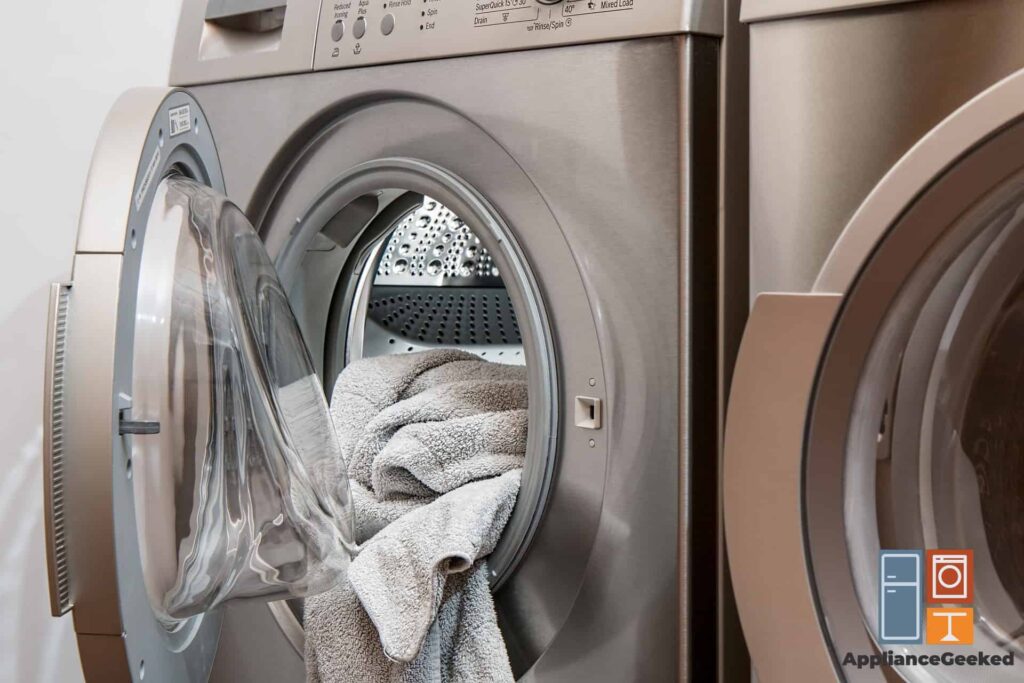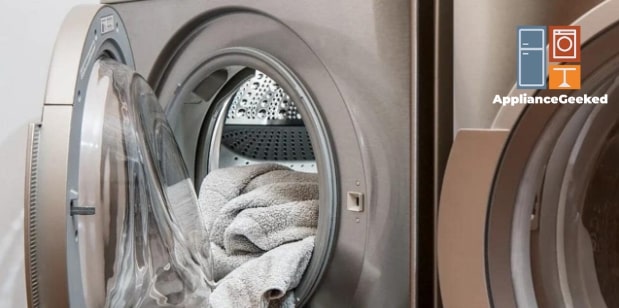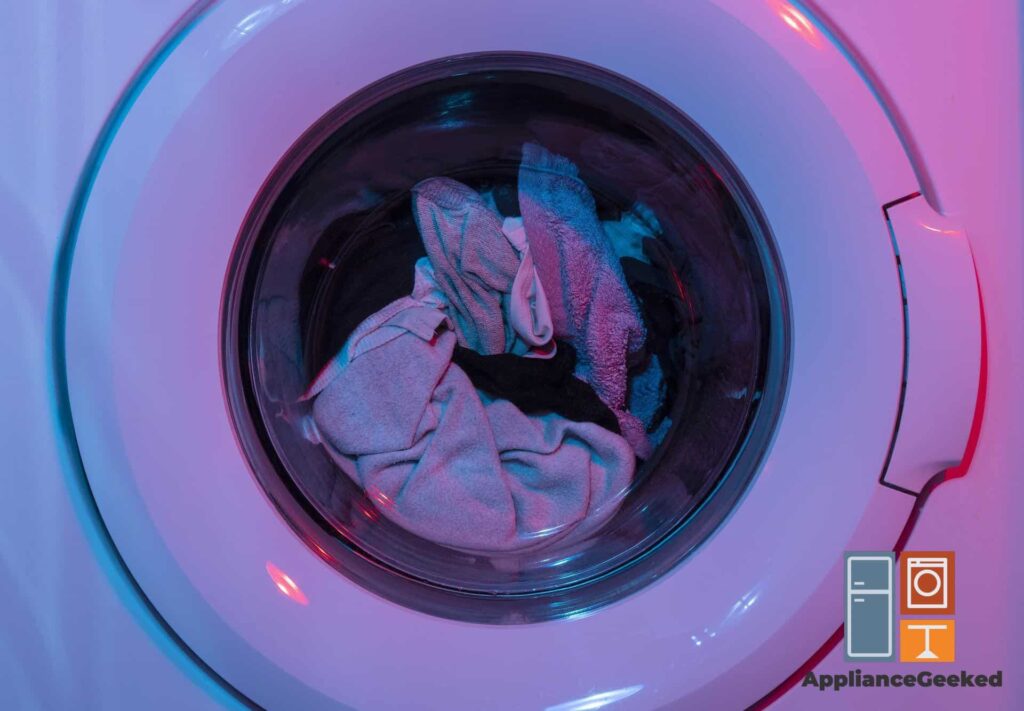Is your Samsung dryer flashing you a combination of letters? Those aren’t random; it’s an error code!
Your Samsung dryer has over a dozen error codes it can send when facing an issue. We examined these codes to help you narrow down the problem.
In this article, we’re diving in on what it means when your Samsung dryer flashes the dC error code and how you can solve it.
What does a dC error code mean?
A dC error code on your Samsung dryer means that it’s facing a door-related issue.
Getting this error code typically means something simple like the drum door being left open for too long or that something is preventing the door from being closed tightly.
There are other variations of this code. Depending on the model of your dryer, it might appear as dE, dF, do, d0, 1 DC, or 1 dF instead.
Your dryer is programmed to only start a cycle when the door is firmly shut. As a result, you’d usually receive a dC error code at the beginning of a drying cycle — and the solution would be easy: just push the door close and make sure nothing’s caught on it!
But when you get this error code at the end of a load, it might mean that the door’s lock mechanism is damaged. When this happens, the door would lock from the inside and refuse to open.
dC Error vs dF Error
The dC error code serves as an umbrella code for all door-related issues — it can mean that your door won’t close, that your door’s switch assembly is loose, that the door latch is damaged, et cetera.
In this sense, there’s not much difference between a dC error code and dF error code.
As a matter of fact, a dF error code is only a specificity. When this appears, your dryer is singling out the door switch assembly to be the issue.
In this case, you can jump straight into troubleshooting that part.
Samsung dryers are smartly designed to make error diagnosis easier for their users, but they can’t pinpoint a specific issue. These codes are more of a guide to tell you which part to inspect first.
Common Causes of the dC Error Code and How to Resolve Them
A door error code is one of the easiest issues your Samsung dryer can face. Sometimes it means you just left the door open for more than five minutes.
The problem gets complicated when your door switch assembly is compromised. In that case, you’ll have to call a professional.
Even if the solution is quite simple, there are plenty of reasons your dryer is sending out this error. We listed them below.
| Cause | Solution |
| Protruding Laundry | Check if any clothes are stuck in the door cavity and are preventing the door from closing. |
| Debris or Foreign Objects | Check if there are any debris or foreign objects (e.g. keys, cards, coins, etc.) stuck in the door cavity or the back of the door’s rubber seal. |
| Loose or Damaged Door Latch and Hinges | Check if the latch is installed securely and that the door opens and closes smoothly. Wipe the latch clean with water and soap. |
| Electronic Lock Malfunction | Test if the dryer door can open correctly by pressing down on the knob. If the door is jammed, call a technician. |
| Mechanical Lock Malfunction | Close the dryer door normally and listen for a click. If you don’t hear one, clean the dryer door — especially the lock — with water and soap, and then restart the dryer. If the error persists or if the door still doesn’t click when you close it, replace the mechanical lock. |
| Faulty Control Board | If you get an error during the drying cycle, call a technician to check on your control board’s processor. If the processor is damaged, it needs to be replaced. |
| Loose or Damaged Wiring | If the error code keeps appearing erratically, check for any loose or damaged wiring on the door switch assembly and control board. |
Most of these issues can be resolved yourself, but it’s still important to know when to call a professional.
To further help you with this discretion, we elaborated on how troubleshooting should work for each problem.
Protruding Laundry
A dC code doesn’t always mean you need your dryer serviced. In fact, the first thing you have to check when you receive this code is simply if you’ve closed the dryer door all the way.
As a safety measure, your dryer won’t start any tasks unless it’s confirmed that the door is firmly closed. When something prevents the door from closing, it sends the dC code as a warning.
Solution: Check for any clothes stuck in the door cavity. When you close the door, watch out for gaps or small openings.
Make sure that your laundry is positioned correctly. Move the clothes farther away from the door cavity.
Moreover, remember that you should only fill your dryer drum 3/4 of the way to avoid any of the clothes from catching on the door.
If the error doesn’t go away upon closing the door, restart your dryer.
Debris or Foreign Objects
A common mistake when doing laundry is forgetting to check the clothes’ pockets for tiny items before loading them into the washing machine or dryer.
Items such as keys, coins, cards, and the like can get caught on the door’s rubber seal during a cycle and jam your dryer’s door.
Solution: Check for any debris or tiny items stuck on the rubber seal. Make sure not to position clothes too close to or under the rubber seal.
Additionally, make sure that the rubber seal fits correctly and isn’t loose. We also suggest cleaning this part out so it doesn’t accumulate lint and dust.
Loose or Damaged Door Latch and Hinges
Frequent opening and closing of your dryer’s door can wear out the latch. When the latch begins to age, your dryer will detect this as the door malfunctioning.
Likewise, if the latch isn’t secure — or, in some cases, if there is damage to the door itself — the dryer’s control panel picks this up as a door error.
Solution: Check if the door latch is secure. If your dryer is new, check if the latch is installed correctly.
Inspect for signs of wear or damage to the latch, the hinges, and the door itself. Replace them as needed.
If the door isn’t opening smoothly, wipe the latch and hinges down with water and soap.
We suggest avoiding using lubricant on your dryer as much as possible because lubricants are flammable materials, and your dryer uses high temperatures to perform tasks.
Moreover, lubricant can attract more lint and dirt.
Electric Lock Malfunction
Sometimes, you can receive a dC error code even when your Samsung dryer is closed, and restarting the dryer doesn’t make it go away.
When this happens, that might mean that the dryer’s electronic lock function has failed.
This is because your Samsung dryer has an electronic lock mechanism that ensures the door stays closed throughout a drying cycle. Like your dryer’s other parts, this can fluctuate or get damaged over time.
You can test this out by pushing down the knob of the door to see if it would open properly. In some cases, a damaged electronic lock means the door is jammed and won’t open at all.
Solution: Check the electronic lock by opening the control panel of your dryer. If you’re not well-versed with mechanical tools or are worried about invalidating your dryer’s warranty, call a professional for this matter.
Otherwise, you can check for the efficiency of the electronic lock yourself by running a continuity test on the dryer’s lock board and motherboard using a multimeter. Make sure to unplug the dryer first.
If it fails the continuity test, the electronic lock needs to be replaced.
Mechanical Lock Malfunction
Aside from an electronic lock, the dryer’s door also uses a mechanical lock to stay in place.
This one is easier to identify, however — just listen for a telltale click when closing the dryer’s door!
If you hear a faint click, that means the door’s mechanical lock is working.
But if there isn’t any, it means the mechanical lock is damaged, and your dryer’s control panel recognizes that the door isn’t closed all the way.
Solution: Check for any lint or dust buildup on the door and the latch. Wipe it down with water and soap.
If the error persists, check if the mechanical lock is securely in place or is damaged. Replace it if necessary.
Faulty Control Board
Sometimes, you’re in the middle of a drying cycle when you receive a dC error code out of the blue, and your dryer stops working midway.
Or maybe you keep receiving this error at the beginning of a cycle, even when you’re sure you closed the door and heard it lock.
When either of these happens, it’s an indication that there’s something wrong with your dryer’s control board.
A faulty control board will misread signals sent to it by sensors, or worse, not process them at all, leading to persistent errors.
Solution: For this issue, you’ll have to detach your dryer’s control panel and inspect the control board. Call a professional if you’re not handy with tools.
Otherwise, you can do this yourself by opening the top cover of the dryer and checking the control panel for any damages.
Check the control board for parts that may need replacement, especially the processor.
Depending on your dryer’s model, the control board can sometimes be found on the back panel instead.
Loose or Damaged Wiring
Sometimes, you’ll get the dC error code out of the blue, and a restart fixes the problem — then the error comes back.
When it keeps coming and going periodically like this, this may indicate an issue with the wiring harness. Wear and tear on the wires can disrupt communication between parts of the dryer, which makes it send erratic false alarms.
To address this issue, you’ll have to inspect the wiring on the door switch and control panel.
The door switch prevents your dryer from running until the door is closed, so any damage to it or its wirings can also send out inaccurate error codes.
Solution: Unplug your dryer and carefully remove its top cover to check for any loose or damaged wiring around the display panel. Do the same for the control board.
The door switch can be found on the door assembly; you’ll have to remove the display panel first to get to it.
Check for any damage to the door switch assembly and its wiring. Replace it if needed.
If this gets complicated for you, call a technician.
Door security is your Samsung dryer’s first step to overall safety, so even if a dC error code can seem so simple, your dryer will understandably be insistent about it.
It can also be a sign that your dryer is aging. Remember to do regular checkups on it, if you can; wear and tear come hand in hand with every drying cycle.




